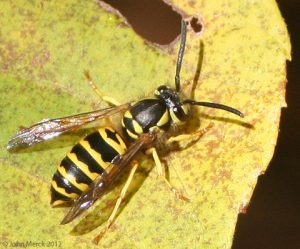Eastern Yellowjacket
By Pat Dickey, Fairfax Master Gardener
 The Eastern Yellowjacket (Vespula maculifrons) is a native wasp that is both a nuisance to humans with its aggressive stings, as well as a beneficial insect for our gardens. Yellowjackets are most notably present in the late summer and fall when their nests become large, and when they forage for sweets and meats that we eat.
The Eastern Yellowjacket (Vespula maculifrons) is a native wasp that is both a nuisance to humans with its aggressive stings, as well as a beneficial insect for our gardens. Yellowjackets are most notably present in the late summer and fall when their nests become large, and when they forage for sweets and meats that we eat.
This native wasp lives mostly in the eastern United States, from North Dakota to Texas and east to the Atlantic Ocean. A worker yellowjacket is a sterile female, 12 mm or ½ inch long. The queen is slightly larger, up to 18 mm. Yellowjackets are black and yellow, and their first abdominal segment has an anchor-shaped black marking. There is also a continuous yellow band that almost encircles the eyes. Vespula denotes a social wasp subgenus. Maculifrons describes spotted markings on the head, another characteristic.
Worker yellowjackets have defined waists and are often mistaken for honey bees that look like them, but do not have waists. The yellowjackets also have hard, shiny, almost hairless bodies, while honey bees are covered with dense hair. Yellowjackets also have developed mouthparts that they use to capture insects and chew meat.
The queen yellowjacket overwinters in a protected location, such as leaf litter or under bark of dead trees. She then searches for the appropriate place for her nest in the spring. This place could be a creek bed, a lawn, a rock wall, the forest floor, or an abandoned nest. Occasionally, a void in the wall or in a structure is selected as the perfect hidden place. The queen builds a small paper nest where she deposits her eggs. She feeds the larvae about 20 days, after which they pupate and emerge as worker-daughters.

Yellowjacket nest
Workers aggressively defend their nest and can sting repeatedly. However, they are beneficial insects that feed on earwigs, caterpillars and beetles and should not be disturbed unless it is necessary. If the nest is too close to a building entrance or is found in an area where mowing occurs, a professional pest control specialist should be called to remove it. Any nests found inside of a building should also be professionally removed. Nests are usually removed late in the night when worker yellowjackets have returned to the nest and are more quiet from the cooler temperatures. Liquid or dust insecticides are used, and those removing the nest will wear protective clothing. Spraying the entire area should be avoided, and bug zappers should not be used.
If you see yellowjackets outside near eating areas or trash cans, do not swat at them or wave your arms. Gently brush them aside from your food. If yellowjackets sting after being bothered, they release a pheromone, a chemical, that signals other wasps to come towards you. If you are stung, apply ice or a sting-relieving ointment or cream. For some people who are allergic, a single sting may cause a serious reaction.
References
Summer stingers, Eastern yellowjackets, Vespula maculifrons, Michael Raupp, UMD Extension
Insect Advice from Extension Eastern Yellowjackets, Penn State Dept of Entomology
Yellowjackets, Ohio State Extension
2018 VA Pest Management Guide, Household Insects, Chapter 6 (Wasps and Hornets)